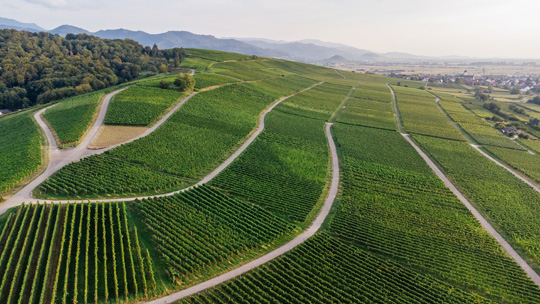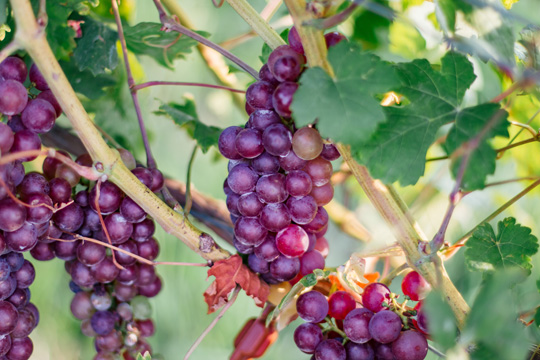Nature’s Tools as Alternatives to Pesticides
Freiburg, Feb 28, 2022
The interplay between different organisms, such as plants, fungi, and bacteria, is a highly complex affair. In the transnational consortium “DialogProTec,” the pharmacist Petra Mußler and the chemist Prof. Dr. Michael Müller from the University of Freiburg are conducting researching to better understand, for example, how differently a plant can use an enzyme in response to changes in its environment – including new diseases caused by climate change.
Life, says Michael Müller, functions sustainably. “All organisms, including plants, fungi, and bacteria, have gotten along for 100 million years by protecting and strengthening each other,” explains the professor of pharmaceutical and medical chemistry. Müller and his collaborator Petra Mußler are currently taking a look at this fascinating and highly complex coexistence in order to gather ideas for sustainable plant protection.
The research the pharmacist and the chemist are conducting is part of a transnational consortium, the so-called Interreg project “DialogProTec.” Its objective is to develop strategies for controlling the chemical dialogue between plant cells and fungal or other organisms specifically and without side effects. To find ecological alternatives to pesticides, the researchers are studying plant immunity, plant growth, and the metabolism of plants and fungi in great detail. Other institutions participating in the project besides the University of Freiburg include the Karlsruhe Institute of Technology and the University of Strasbourg.
Enzymes like Swiss army knives
“The chief concern of the project is to understand nature better, or more precisely: the interplay between different organisms,” explains Müller. His research group is studying the biosynthesis of natural products. Back when he was still a student himself, says Müller, the prevailing assumption was that an enzyme has exactly one function in plant metabolism. Today it is known that nature uses enzymes in the same way that we use a Swiss army knife: They have various functions that are used depending on the requirements. “Now we see that nature is increasingly using enzymes differently than previously; it is responding to the changes brought on by climate change,” says Müller.
A connection Müller and Mußler are particularly interested in is that between a plant and a potential pest, in concrete terms: grapevines and fungi. A fungus will never completely destroy a vine, because it would thus lose the basis for its livelihood. An exciting question to answer is why this liaison works so well: Does one of the two produce something for the other? Does the plant, for example, produce a substance that is beneficial to the fungus? Or is it the other way around? Or, as a third possibility, do they each create a substance from which the other benefits? “There are a great many plants that can only grow well when they are ‘infested’ with a fungus,” explains Petra Mußler.
Not every fungus makes the vine sick
One example is mycorrhizal fungi. Also interesting is esca disease: If a vine is infested, it may be protected from damage from bacteria, but the vine may also be weakened. Not every plant on which a fungus lives becomes sick. Moreover, scientists are far from knowing every existing fungus. In other words, perhaps there is one that lives on a plant and interacts with it, but we are not even aware of it.
Because organically grown foods are becoming increasingly important, fungus-resistant grape varieties are also becoming more important. Consumers do not want to buy wine that has been treated with industrially produced fungicides and insecticides. “Conversely, this does not automatically mean that every substance that is natural is also sustainable,” says Müller. “However, it can be better insofar as it is degradable.”
Marveling at nature’s diversity
What Müller and Mußler are currently engaged in is fundamental research. They are describing things and marveling again and again at nature’s fascinating idiosyncrasies. Such as botrytis. This sac fungus brings about different effects depending on the degree of ripeness the grapes of infested vines have attained. “If the grapes are still young, they will rot, but if the fungus only becomes active at a later point in the ripening process, the grapes receive a very special aroma,” explains Mußler. However, this note only makes Riesling into a fine wine.
The two Freiburg researchers have often been compelled to realize that there is no such thing as “simple” in nature. “Whenever you assume a simple mechanism, you suddenly find yourself immersed in a highly complex network of functions and dependencies,” says Müller. “We’re trying to shed a little light into the darkness, even though we’re well aware that humans will never understand these things in their entirety.” He compares it to the knowledge we have gained about antibiotics: A few decades ago we were still convinced that we had bacterial infections under control thanks to the discovery of antibiotics. Today we know, also due to the increasing number of multiresistant bacteria, that we need to find new paths and learn to deal with them.
New findings in chemical ecology
Müller is certain that the future of infection control will be more diverse. Instead of relying solely on antibiotics, we will increasingly use a combination of phages and antibiotics. Phages are viruses that multiply in bacteria and destroy them. Scientists have already had initial success with this method. “If you take the same antibiotic in lower amounts than previously but add phages to it, it can even effectively fight multiresistant strains,” Müller explains.
“Merely saying that we have a new fungicide or herbicide is far too short-sighted,” says the chemist. “After all, we know today that the interplay between different organisms does not take place at the macroscopic level, that which can be seen with the naked eye, but at the molecular level.” Time and again, he is surprised to find that his own models, which are designed to explain complex processes in as comprehensible a way as possible, are too simple, because second, third, and fourth functions of enzymes suddenly appear.
It is therefore just not possible to represent the complex reality of chemical ecology with models that serve to simplify it, says Müller. But still, he and Mußler are convinced that their work is helping to examine nature’s tools a bit more closely. “Once I’m familiar with the additional, previously unknown functions of an enzyme, I have more points where I can intervene,” says Müller. “That extends the options in the long term.”
Claudia Füßler



